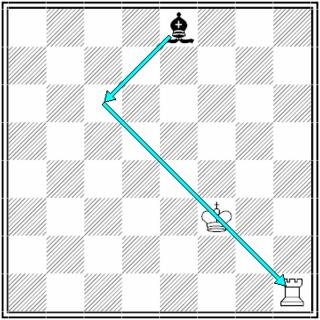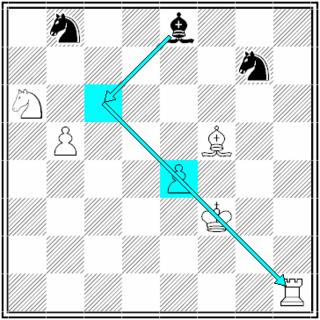The Space-Time continuum
King of the Spill commented here that we might have found a winning scansystem (or at least drawing:)
If I look at the figures (before 0+ 0= 35- after 1+ 8= 6-) I am convinced that IN POTENCY that is the case. The scansystem has one main drawback, it consumes an enormous amount of time.
I need about 5 minutes per scan. That is way too much. I have to stay focussed during this time which costs much energy. This is exhausting so an error is easely made. Hence the minus 6 score.
The X-rake scan from my previous post was an attempt to diminish the required scantime.
What is the idea behind this rake?
I will try to explain.

White to move (diagram above)
The scan reveals a rake with one tooth. . .
This rake allows you to have a look in the future.
If white doesn't do anything about it, he will loose his rook within 4 ply.

White to move (diagram above)
The route to the rook is hindered by the pawn on b5.
The danger is that black trades pieces on a6 and that the rook is lost within 6 ply

White to move.
Here are two impediments on the route.
The danger here is that black trades pieces on a6 and f5.
The rook is then lost within 8 ply.
So time can be represented as a geometrical pattern.
Scanning for these patterns helps to avoid blunders and to look for tactical shots yourself.
These patterns don't pop out for me at the moment.
This means that I have to scan every tooth of the rake.
I have been drawing some teeth lately. . .
If I combine the X-ray scan with real scan (see Mousetrappers blog) I can omit the scanning of some teeth. The method is still under construction, but the scantime is halved already.
To be continued. . .
Some find it hard to believe that the patterns of our blunders are allready in our system.
But that's easy to check: set the computer at 6 ply, play and write your errors down.
If you are a solid class D player you will find that your errors contain only patterns you are already familiar with.
A 1700 player at the top of the bell-curve has about half the amount of patterns stored of a grandmaster. So the 1000 extra patterns of CT-art are not going to change that dramatically.
I don't intend to cast doubt on the 7 circles. The circles is step 2 of the program.
Though all Knights more or less improve due to the circles, I feel some disappointment since nobody seems to come near the progress of DLM from 400 points in 400 days.
We must do something wrong!
The discussion above is about step 3 though: how to apply your patterns to your play.
I am inclined to think we are making progress at step 3.
I'm curious how things appear to work out.
If I look at the figures (before 0+ 0= 35- after 1+ 8= 6-) I am convinced that IN POTENCY that is the case. The scansystem has one main drawback, it consumes an enormous amount of time.
I need about 5 minutes per scan. That is way too much. I have to stay focussed during this time which costs much energy. This is exhausting so an error is easely made. Hence the minus 6 score.
The X-rake scan from my previous post was an attempt to diminish the required scantime.
What is the idea behind this rake?
I will try to explain.

White to move (diagram above)
The scan reveals a rake with one tooth. . .
This rake allows you to have a look in the future.
If white doesn't do anything about it, he will loose his rook within 4 ply.

White to move (diagram above)
The route to the rook is hindered by the pawn on b5.
The danger is that black trades pieces on a6 and that the rook is lost within 6 ply

White to move.
Here are two impediments on the route.
The danger here is that black trades pieces on a6 and f5.
The rook is then lost within 8 ply.
So time can be represented as a geometrical pattern.
Scanning for these patterns helps to avoid blunders and to look for tactical shots yourself.
These patterns don't pop out for me at the moment.
This means that I have to scan every tooth of the rake.
- Bishops 2 x 30 sec = 60 sec
- Rooks 2 x 30 sec = 60 sec
- Knights 2 x 45 sec = 90 sec
- Queen 2 x 30 sec (B+R) = 60 sec
I have been drawing some teeth lately. . .
If I combine the X-ray scan with real scan (see Mousetrappers blog) I can omit the scanning of some teeth. The method is still under construction, but the scantime is halved already.
To be continued. . .
Some find it hard to believe that the patterns of our blunders are allready in our system.
But that's easy to check: set the computer at 6 ply, play and write your errors down.
If you are a solid class D player you will find that your errors contain only patterns you are already familiar with.
A 1700 player at the top of the bell-curve has about half the amount of patterns stored of a grandmaster. So the 1000 extra patterns of CT-art are not going to change that dramatically.
I don't intend to cast doubt on the 7 circles. The circles is step 2 of the program.
Though all Knights more or less improve due to the circles, I feel some disappointment since nobody seems to come near the progress of DLM from 400 points in 400 days.
We must do something wrong!
The discussion above is about step 3 though: how to apply your patterns to your play.
I am inclined to think we are making progress at step 3.
I'm curious how things appear to work out.
I am doing pretty well. I already have gained about 200 points. But you do have a point, we recognize the errors we make. Thay aren't a subtle positional blunder that we don't understand, they are tactical mistakes.
ReplyDelete5 minutes per scan is fine for me, provided I am playing a long standard game and I bang out the opening from memory.
ReplyDeleteYou really are at the beginning of a new discipline of systematic positional assessment. I imagine in 50 games time you will be quicker or more efficient if you consistently practice it.
I find my "every move" discipline is not always good, and is something I probably will work on after the circles.
By the way-nice instructive pictures.
ReplyDelete"If I look at the figures (before 0+ 0= 35- after 1+ 8= 6-) I am convinced that IN POTENCY that is the case."
ReplyDeleteCan these figures truly be compared. I mean with the 35 losses you were playing G/15. You said you needed more time for your system so you started playing G/60. I can't tell for sure if your method is working. And i'm quite sure other knights are reading mousetrapper's and your posts but not sure what to think.. we need more solid proof that this works before we can try it. IMO it all seems too simple to be tactics proof. No criticism ment in any way :)
Java, you are right of course and I am glad you read my blog so well.
ReplyDeleteNothing is proven yet.
If I was writing a book, I wouldn't have this published. But it's a weblog, and what you see is my daily struggle with chess improvements. This means you can see me change opinion 180 degrees any time new insights arise.
Can those figures be compared?
Scientificly not of course.
But in a subjective way they can.
If I play full throttle against the computer at 6 ply, my results would come near 100%. After the opening I would take half an hour or so to set a trap at 7 ply deep and voila (I tested this).
But I commit myself to:
1. Just scanning.
2. The only plans I allow myself are the simple ones of DLM: improve mobility, keep queen on the board, trade off pawns and prevent the opponent from castling.
I don't play chess against the computer, I train a scanningmethod.
And if I take rest from that, I think about it. And I write blogs about it.
So at the moment I have nothing.
Because the scansystem isn't workable yet. Only when a scan can be done in about 1 minute, it will be usable in practice. And thus the only things I can share with you are my convictions. Which can change overtime.
Dr. Elo will be the final judge if there is something in it. At least my English is improving.
Your english is good. Dr. ELO will be interesting :). If this all does work out, it'd be interesting. gl with it :)
ReplyDelete